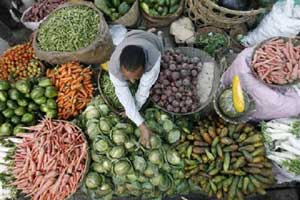Retail inflation eased to 3.66% in August from a revised 3.69% in the previous month and wholesale price inflation hit a fresh low of -4.95%, remaining in the negative zone for 10 consecutive months now, as a broad-based fall in commodity prices deepened further, showed official data released on Monday, reports fe Bureau in New Delhi.
Coming on the back of a slowdown in industrial production to 4.2% in July from 4.4% in June, the easing price pressure has made a strong case for the central bank to ease its policy rate for a fourth time in 2015 in its next review meeting on September 29. Expecting a 25-basis-point cut later this month, some analysts said the fact that CPI core inflation eased for a second straight month to 4.1% in August, versus 4.3% in July, has further enhanced the leeway for the Reserve Bank of India (RBI) for a rate cut.
However, the central bank would be closely tracking potential risks from a deficit monsoon as well as a likely interest rate hike by the US Federal Reserve, they said. Any indication to this effect from the Fed’s meeting this week would be crucial, they added.
Food inflation — for long an irritant in both the price gauges — stood at 2.2% in August in the Consumer Price Index, against 2.15% in July. In the Wholesale Price Index, food inflation hit -1.13% in August, compared with -1.16% in July, its lowest in at least since April 2005 when the current WPI series was launched. This suggests despite deficient monsoon rains in August, prices of most food items remained firmly subdued.
Since global commodity prices are expected to remain low for some more time and food and fuel items comprise more than a half of the CPI basket, some analysts expect retail inflation to undershoot the RBI’s stated inflation target by January, even taking into account the fact that the favourable base effect might wane from this month. The RBI’s glide path calls for retail inflation under 6% by January 2016, 5% by January 2017 and 4% by March 31, 2018.
Although the monsoon deficit has been as high as 16% so far this season, the government is expecting a better kharif harvest in 2015-16 due to higher area under various summer-sown crops, compared with a year earlier.
So while industry chambers renewed calls for a rate cut on Monday, even policymakers have been pitching for a monetary easing.
NITI Aayog vice-chairman Arvind Panagariya last week said the economy needed 50-100 bps of rate cuts, while chief economic adviser in the finance ministry Arvind Subramanian warned early this month of looming deflation and called for measures to boost consumer demand and step up investment.
Even according to the gross value added deflator, inflation in industry and services was -0.7% and -0.6%, respectively, from a year ago, while that in agriculture it was 4.5%, as reflected in the latest GDP data for the first quarter of this fiscal.
“Given that CPI inflation has also been declining, RBI needs to reduce interest rates sharply to drive a recovery in demand,” CII director general Chandrajit Banerjee said. CII expects the RBI to reduce interest rates by 50 basis points in the forthcoming policy with statements supporting further easing in the near future, he added.
